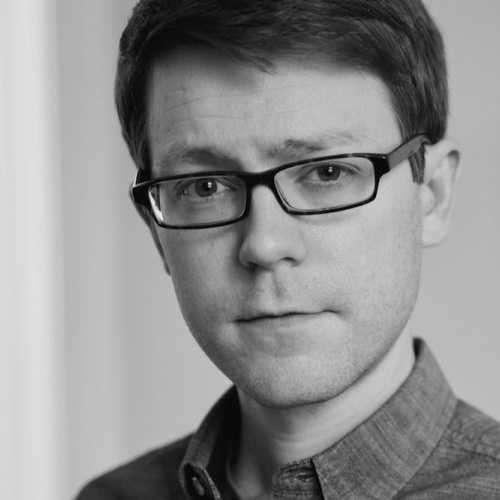What happens when we forget?
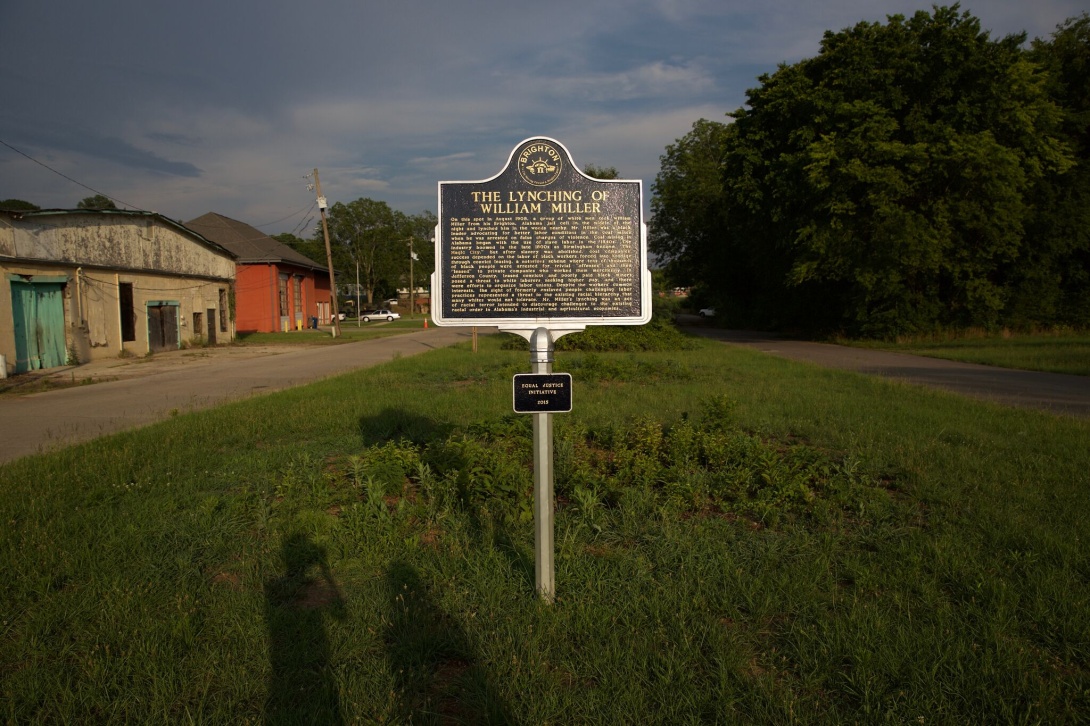
A rare sight: a marker commemorating a lynching, this one in Brighton, Alabama. (Photo by Lance Warren.)
We didn't know. Why didn't we know?
The truth crept in — unexpected, unsought, unforgettable. Yet so many had forgotten; so few knew. We had to know why.
My wife, Hannah Ayers, and I were running workshops for history teachers, hearing lectures by scholars who again and again mentioned lynching. These mentions were brief, but mind-expanding. Until then, we knew only the borders of this history, the edges that are common knowledge. We started hearing that it was not only men who were killed, not only hangings, and not nearly as confined in time as we'd understood. It was women, it was children; it was burning, it was shooting. It was not the sidebar in our high-school history textbooks but an era, one enduring in ways impossible to miss once you start looking. For fully one-third of American history, Black citizens, predominantly in the South, were killed with regularity, the destruction of their bodies as reliable as the absence of arrests that followed.
Lynching, we learned, was an integral part of the American experience. Lynching defined the limits of American citizenship. In the earliest days of emancipation, lynching brought forth a new nation dedicated to the principles of the old.
Lynchers made a mockery of the 14th Amendment even before the ink dried, denying to Black Americans due process and equal protection of the law — denying the privilege of life itself. Indeed, lynchers made clear that the safety of one's body was a privilege to be held by whites alone. Where the newest law of the land sought to protect the newest Americans, lynchers successfully opposed all efforts to stop extralegal killings by claiming that the law left them and their families vulnerable to Black crime. Myths of "super-predators" weren't dreamt up yesterday.
And so lynching spurred the Great Migration, even as it stretched into the North. Yet it was everywhere and nowhere. From Gainesville to Gettysburg, monuments to dead Confederates took shape in cocky defense of a cause that was far from lost. In stone, with the blessing of white community leaders honoring ancestors who had died to sustain slavery, lynchers covered their tracks. They ensured that lynching would be forcibly forgotten — though not by the thousands of families it touched.
Hannah and I had time and a little money. We had skills in documentary film production that could enable us to make this history better known, to address a far from settled past that implicates us all. We decided to make a film. We quit our jobs, we hit the road, and we tried to make it matter.
* * *
The Murder of Ell Persons
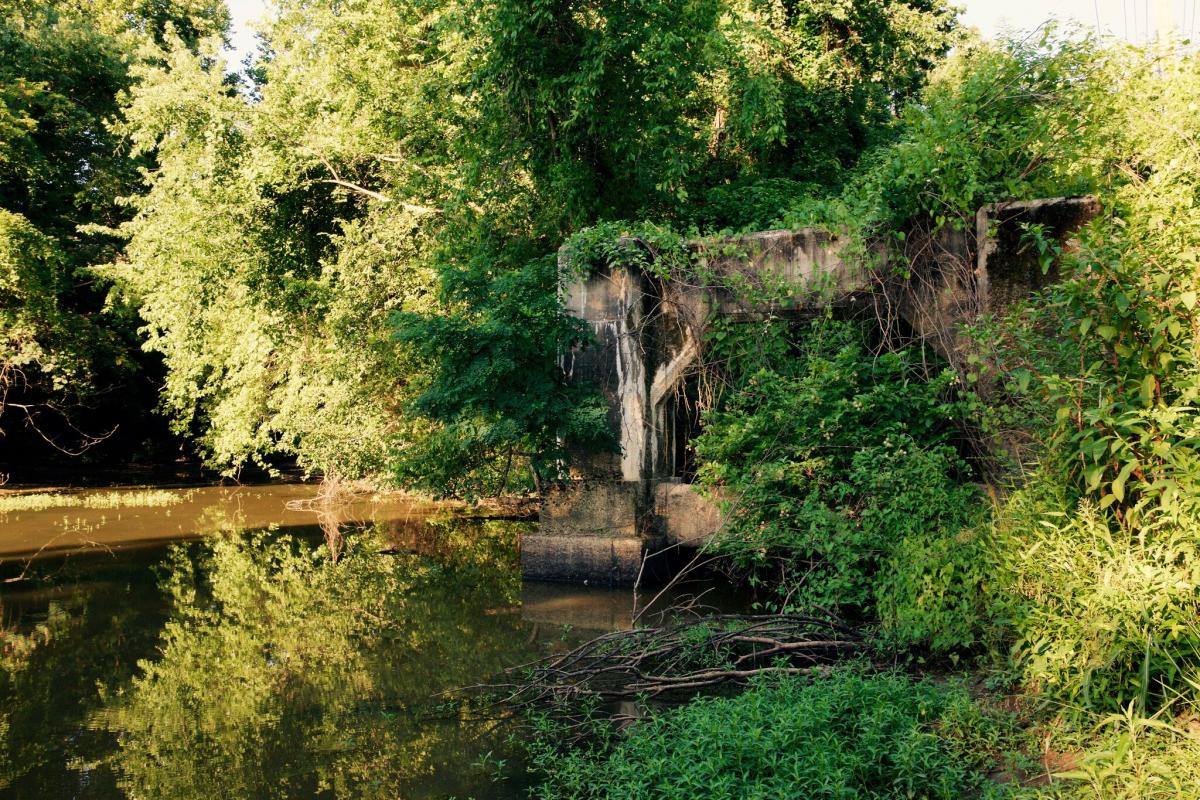
Site of the lynching of Ell Persons (May 22, 1917), Memphis, Tennessee. (Photo by Lance Warren.)
The sweat that pools before sunrise previews the day ahead. It will be a day of exertion. This day, it will also be a day of remembrance. We start early.
Hannah and I had traveled to Memphis as part of a 3,200-mile trip through the South to document a history of lynching and forgetfulness. The scene we confronted on this morning spoke not at all of the Memphis a would-be tourist might imagine. Barbecue, Beale, the placards of the National Civil Rights Museum — none were in sight. We asked what locals would call this part of town and our guides searched several moments for an accurate reply before telling us, "It doesn't really have a name." In recent decades, few who call Memphis home had ever been here.
"Here" was a jarring place, a place where Ell Persons, an African-American man, was burned alive before a crowd of thousands in 1917. "Ell Persons was a family man," Rev. Andre Johnson, our guide for the morning, told us. He chopped trees, bundled logs for firewood, kept Memphis families warm and his family fed. "He was trying to make a living," Rev. Johnson explained, "and just got snatched up."
The atrocity was planned. The site, by a once well-traveled bridge now accessible only by bushwhacking through dense overgrowth, was selected for the wide view it afforded. Newspapers ran ads in advance; vendors sold concessions and souvenirs. Parents attended with their children. City leaders, factory workers, farmers — a cross-section of the city — peopled what proved to be one of the city's major events that year.
Ell Persons was dismembered after flames consumed his body. For days, his remains were displayed along Beale Street. One white newspaper, echoing the sentiments of the others, judged the proceedings "orderly."
* * *
The Murder of Henry Smith
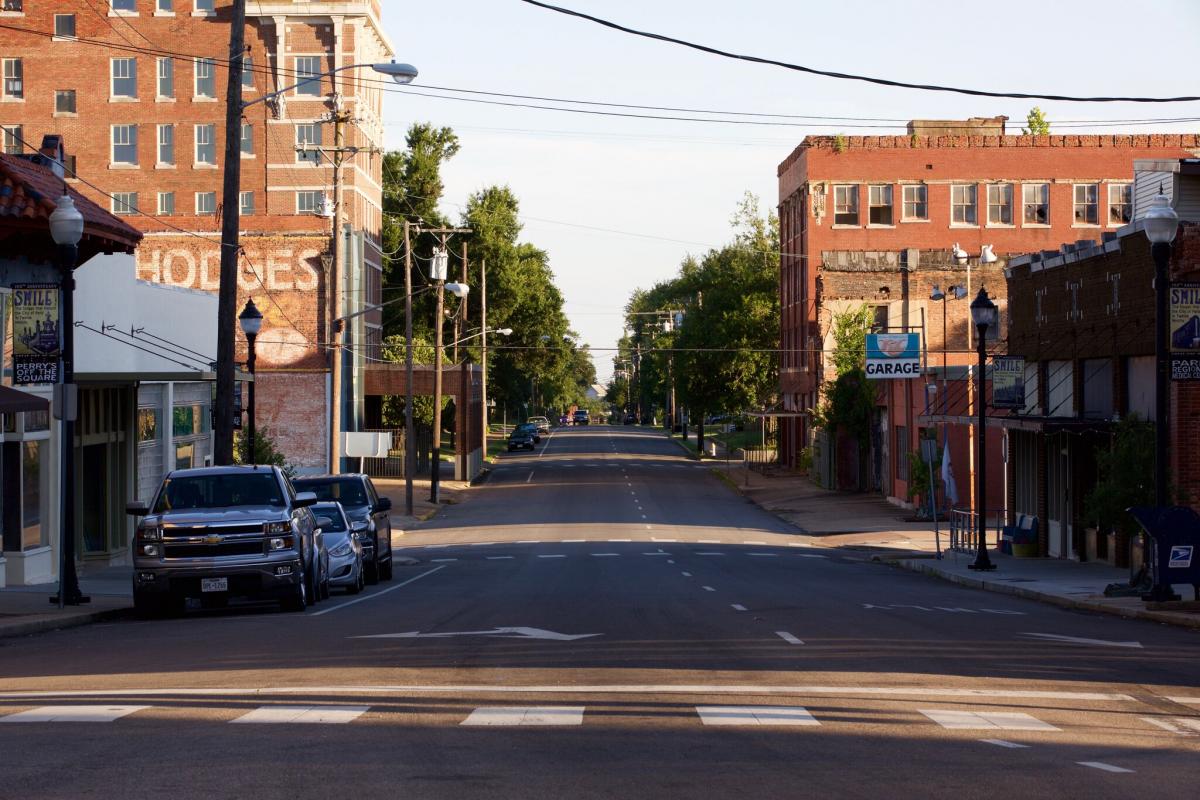
Path to the site of the lynching of Henry Smith (Feb. 1, 1893), Paris, Texas. (Photo by Lance Warren.)
Paris tells you to smile. How could you? You're here to consider the 1893 lynching of Henry Smith, a mentally disabled African-American man framed for murder. The town murdered him, after parade and torture, on a purpose-built scaffold emblazoned with the delusion of its cause: "JUSTICE."
The town square is lovely today. Healthy green grass surrounds a monument and fountain cut from Italian marble honoring the town leader who built it, a cotton and oil magnate whose installation of the centerpiece in 1927 marked a reboot for Paris after a devastating fire 11 years earlier. This is why the banners circling the square encourage you to "SMILE!" They mention the fire. They tell you how undaunted Paris residents rebuilt what was lost. And they tell you the town will never be defeated. The town will always prevail.
This seems true, for Paris still has the final word on Henry Smith. In a town center rife with historical plaques and tchotchke shops, there is no acknowledgment of the horror the town heaped on an unwanted citizen. Townspeople 10,000 strong gathered in the square and then walked south to the killing ground. Cotton grew nearby, as it had for generations.
"My family were slaves here," Thelma Dangerfield told us as she explained her determination to document and preserve the Smith story. Dangerfield, a officer of the Paris chapter of the NAACP, had grown up in town, moved to California to marry and make a career, and then, unlike her brothers and sisters, returned. Something pulled her home.
Retiring to Paris, Thelma took an interest in local history, and soon she was assigned to curate what was informally known as "the Black Room" at the Lamar County Museum. She uncovered the history of Henry Smith's lynching and assembled the few scraps of archival material held there that described his life and death. Since childhood, Thelma had been aware of danger in Paris. "I remember in my house at night," she recalled, "if a white person knocked on our door in the middle of the night, my dad always opened the door — and one of my brothers had a gun pointed at the door from the back room." But even Thelma couldn't come to grips with the awfulness of Henry Smith's killing.
"He was dead from the lynching," she told us. "Then they burned him. They gouged his eyes out. And they just kept killing him over and over in their minds."
"It was just so vicious. How could anyone do anything that vicious?"
* * *
The Murders of Major and Andrew Clark, Maggie and Alma Howze, Ernest Green, and Charlie Lang
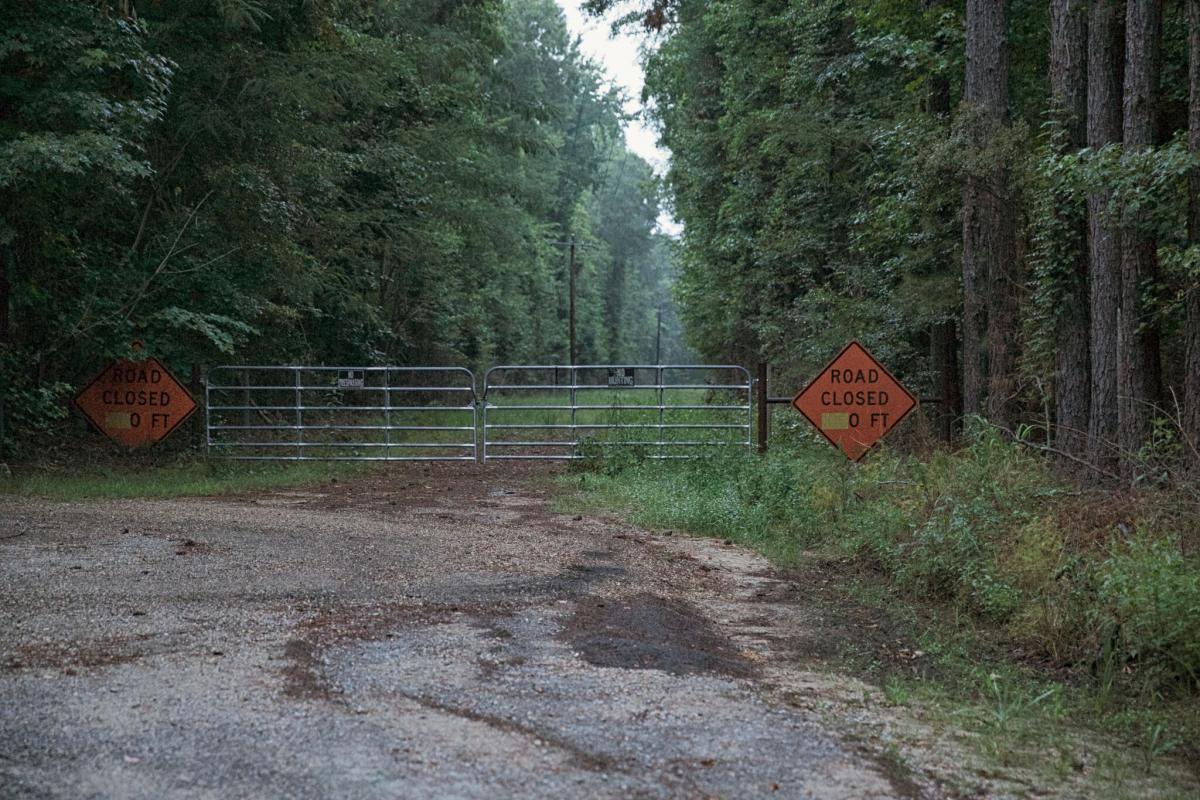
Roadblock near the Hanging Bridge, site of the lynchings of brothers Major and Andrew Clark and sisters Maggie and Alma Howze (December 20, 1918), and Ernest Green and Charlie Lang (Oct. 6, 1942), Shubuta, Mississippi. (Photo by Lance Warren.)
"People don't need to see that," the local official had told Jason Ward, an historian at Mississippi State University, when asked why a gate cut off the road leading to Shubuta's Hanging Bridge. Now, hearing our interest in taking a look despite the roadblock, Jason told us: "'NO TRESPASSING' signs are not to be taken lightly in Mississippi. Plus, you have the misfortune of arriving after me."
Lynching — extralegal, socially-sanctioned murder — has occurred around the world. American lynching is especially Southern, and in this regard, Shubuta is about as Southern as it gets. Two brothers and two pregnant sisters were lynched here in 1918; in 1942, while the United States fought tyranny abroad, two more young African Americans were put to death in Shubuta. Each died above the Chickasawhay River, strangled from a span that earned its name.
The town cemetery features an obelisk inscribed "To Our Confederate Dead." As with all but a very few lynching sites, there are no official markers in Shubuta to the results of the white supremacy that Confederates won. The de facto monument of the Hanging Bridge is unusual; most of the killing sites do not betray their histories. But in Shubuta, this history is hard to see.
McArthur "Sonny" Gray took us to the one other spot in town where the most important chapters in Shubuta's history can be glimpsed — the graves of Ernest Green and Charlie Lang. An elderly African-American man who keeps mowed a grassy path to the site, Sonny doesn't consider himself an activist. And he isn't inclined to political speech. In truth, we might have hoped he would offer an indictment on camera. In more than 80 years, he has seen much — but perhaps too much.
"I've heard about the Hanging Bridge all my life," he told us. But Sonny said Black residents of Shubuta don't talk much about it these days. "The way I see it," he explained, "now they're trying to let it die down as much as they can. They really don't even want to bring it up." In the summer of 2016, during an exceptionally ugly presidential campaign and Mississippi's evergreen racial tension, Sonny saw the silence as evidence that "everybody's trying to get along."
"You know," he added, fellow Black folks in town "don't bring up the old stuff like that, because it might make the young people feel kind of funny towards white people." For Sonny, it seemed, unease might be too dangerous to invite.
"When you get to town," Jason Ward had advised us, "everyone will know right away." At dusk, after an hour there meeting with Sonny Gray, we filmed briefly along Shubuta's High Street. A pickup truck made its third pass in five minutes. We took to the highway, the sky exploded in a midsummer storm, and we sped to Jackson.
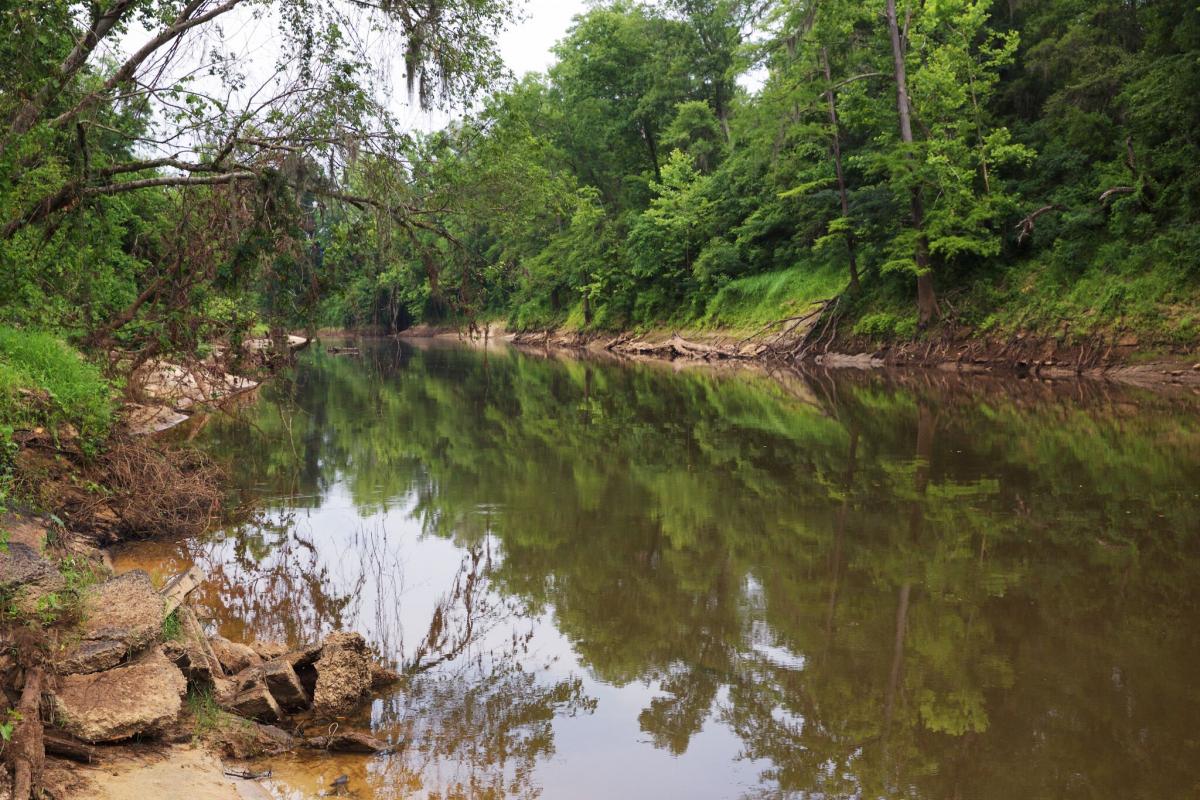
The Chickasawhay River bends near Shubuta, Mississippi, home to the Hanging Bridge, site of six lynchings of African American men, women, and boys between 1918 and 1942. (Photo by Lance Warren.)
Following the lynchings in Shubuta, Mississippi, of brothers Major and Andrew Clark and pregnant sisters Maggie and Alma Howze in 1918, the NAACP requested an investigation.
Asked by a reporter how he would answer the inquiry, Mississippi Gov. Theodore Bilbo replied: "I will tell them, in effect, to go to hell."
(Quoted by Jason Morgan Ward in "Hanging Bridge: Racial Violence and America's Civil Rights Century.")
* * *
The Murder of Sam Hose
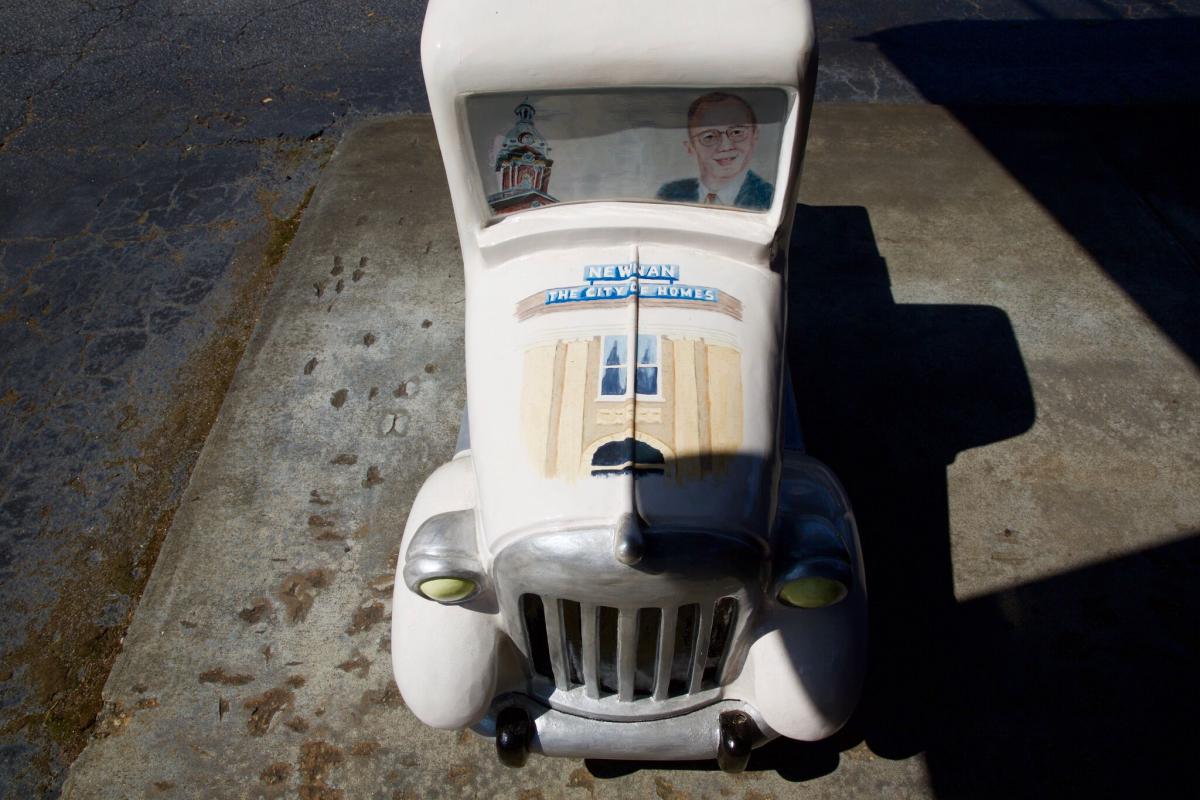
Decoration near the site of the lynching of Sam Hose (April 23, 1899), Newnan, Georgia. (Photo by Lance Warren.)
Sam Hose grew up on a farm not far from Macon, Georgia, about 80 miles southeast of the town where he would be killed. He was a newcomer to tiny Newnan, in town for just six months and working for a white farming family there, when a young girl died and locals spun their sadness into rumor and threat. As in so many towns where air thick with white supremacy erupted into storms of murderous violence, logic had no quarter. Sam Hose was accused of crimes with details that grew gorier and less believable each time they were relayed. Surely, the townspeople concluded, no one in Newnan could have done such things, and who could trust the outsider — the Negro outsider, the Negro male outsider? You know what they do, right?
The mob captured Sam Hose and dragged him through the center of town. They passed a butcher and a bakery and arrived on the courthouse square. Newnan native William Yates Atkinson, freshly home following his term as governor of Georgia, knew they were coming, and he urged calm. "The law will take its course," he shouted as a mob leader trained a gun at his head. "I promise it will do so quickly and effectually. Do not stain the honor of this state with a crime such as you are about to perform."
Six years earlier, Atkinson had successfully pushed the passage of a state anti-lynching law, rare in the South, establishing a penalty of four years in prison. But even this relative slap-on-the-wrist was rarely enforced, and the new governor openly supported lynching as a means of enforcing white public safety. Atkinson couldn't keep the peace.
Sam Hose was stabbed, doused in kerosene, burned, and dismembered. His bones were distributed as souvenirs in Newnan and elsewhere in Coweta County. The young sociologist W.E.B. Du Bois encountered Hose's knuckles for sale at a grocer while en route to a meeting, and he turned around and went home. The sight "pulled me off my feet," he later wrote, concluding that "one could not be a calm, cool, and detached scientist while Negroes were lynched, murdered, and starved."
Ida B. Wells had taken up the cause that would shape her life as an anti-lynching activist after the murders of two close friends. The murder of Sam Hose resolved Du Bois, then principally a researcher, to launch his own lifelong fight for Black freedom. Yet when Du Bois passed away the night before the 1963 March on Washington for Jobs and Freedom, at the end of a summer that saw the killing of Medgar Evers on the front lawn of his home while his family sat inside, that quest — the Rev. Dr. Martin Luther King Jr.'s “dream" — felt to him as elusive as ever.
Last fall in a new book, University of North Carolina historian Donald Mathews quoted a report from Newnan documenting the scene of Sam Hose's murder. "Glory!" an old white man in the crowd had shouted. "Glory be to God!!" Mathews, an historian of religion whose own grandfather was lynched outside a rural Kansas prayer meeting, finds in the Newnan mob and many others across the South a sacrificial intent. The murderers, he writes, "worshipped at the altar of race, which meant they were willing to sacrifice another human being to sustain the transcendent meaning of whiteness."
From what we could see, whiteness in Newnan still transcends. White residents of Newnan in recent years have successfully opposed calls for a marker to acknowledge the murder. The town is home to one of Georgia's few county museums dedicated to African-American history. But remembrance in Newnan has its limits. We found a barbecue joint with nostalgic decoration facing the lynch site.
* * *
The Murder of William Miller
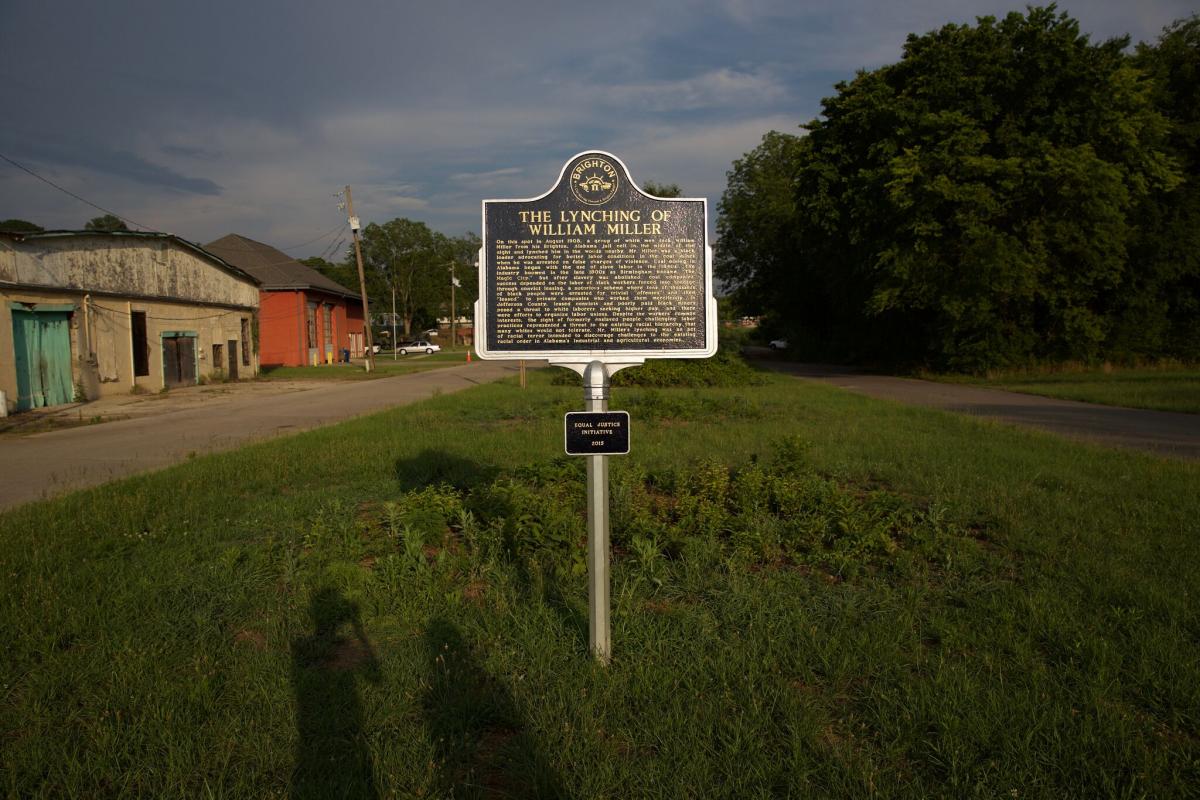
Site of the lynching of William Miller (Aug. 4, 1908), Brighton, Alabama. (Photo by Lance Warren.)
The marker stands alone on a patch of weedy grass between the main drag and a row of well-worn shops in Brighton, Alabama. After driving for days through the South, it feels foreign, fabular: a missing link between history and memory, as impossible as it is necessary. The marker describes a lynching.
William Miller, we learn, was a coal miner. Perhaps he was also a husband, a father, a best friend, connected to this world through ties we will never know. But we know that he mined coal. And we know he was murdered here after attempting to unionize fellow Black miners. As the marker explains, "the sight of formerly enslaved people challenging labor practices represented a threat to the existing racial hierarchy that many whites would not tolerate." William Miller had stepped up, and stepped out of line.
Miller's leadership made him exceptional. But African-American miners once formed a substantial share of the workforce in coal country. Several years earlier on another production trip, Hannah and I had found ourselves in Lynch, Kentucky, now home to 740 residents but once an industrial powerhouse supporting a population of 20,000 miners and their families. Placards showed us pictures of a fine hotel razed long ago, workers chopping trees and laying rails, a community built to wrench power and prosperity from hills that still tower on either side of the narrow road that links Lynch with other defunct company towns. And inside the mine shaft now home to tours and historical markers, we read that nearly 80 percent of the workers who mined the coal were Black.
We realized then that we had never seen pictures of African-American coal miners. As for the photos we had seen of tired, white faces grimy with coal, it turns out that in Lynch and elsewhere in Appalachia, those workers were often the bosses of Black miners. For men like William Miller and their families, Lynch and other company towns were often stops en route North — to the factories, slaughterhouses, packing plants, and other sites of newfound toil where the children and grandchildren of enslaved families remade the nation. The Great Migration ran through the mines, and William Miller sought to make his better.
The front of the marker relays Miller's fate; the back explains the nature of lynching in the South. The fact of these words, cast in iron and cemented in soil that once supported the jail from which Miller was dragged — the fact of these words on public display in rural Alabama, in a region of unmarked killing fields, points to an even larger story: the efforts of activist attorneys at the Montgomery-based Equal Justice Initiative to confront this past.
William Miller's marker is the work of these advocates. Their practice focuses on freeing wrongly-convicted Black men from Southern death rows, work they see as an extension of lynching protests begun a century earlier by those like Ida B. Wells, Mary Church Terrell, and W.E.B. Du Bois, who worked for African-American civil rights long before the heroic years venerated on signs and memorials much easier to reach. They also built a National Memorial to Peace and Justice. The broad structure, set among six acres in Montgomery, features 800 stone pillars representing the counties where the group has documented lynchings. They urge these communities to come to the memorial site, claim their columns, and then take them home to install in public spaces acknowledging histories long forgotten, long hidden, and long denied.
Today, 59 monuments to the Confederacy stand in William Miller's home state alone. The visions of the past they illustrate obscure the fullness of Alabama's history. But in Brighton, we're fortunate to learn of William Miller. And we will tell others.
* * *
The Murders of George and Mae Murray Dorsey and Roger and Dorothy Malcom
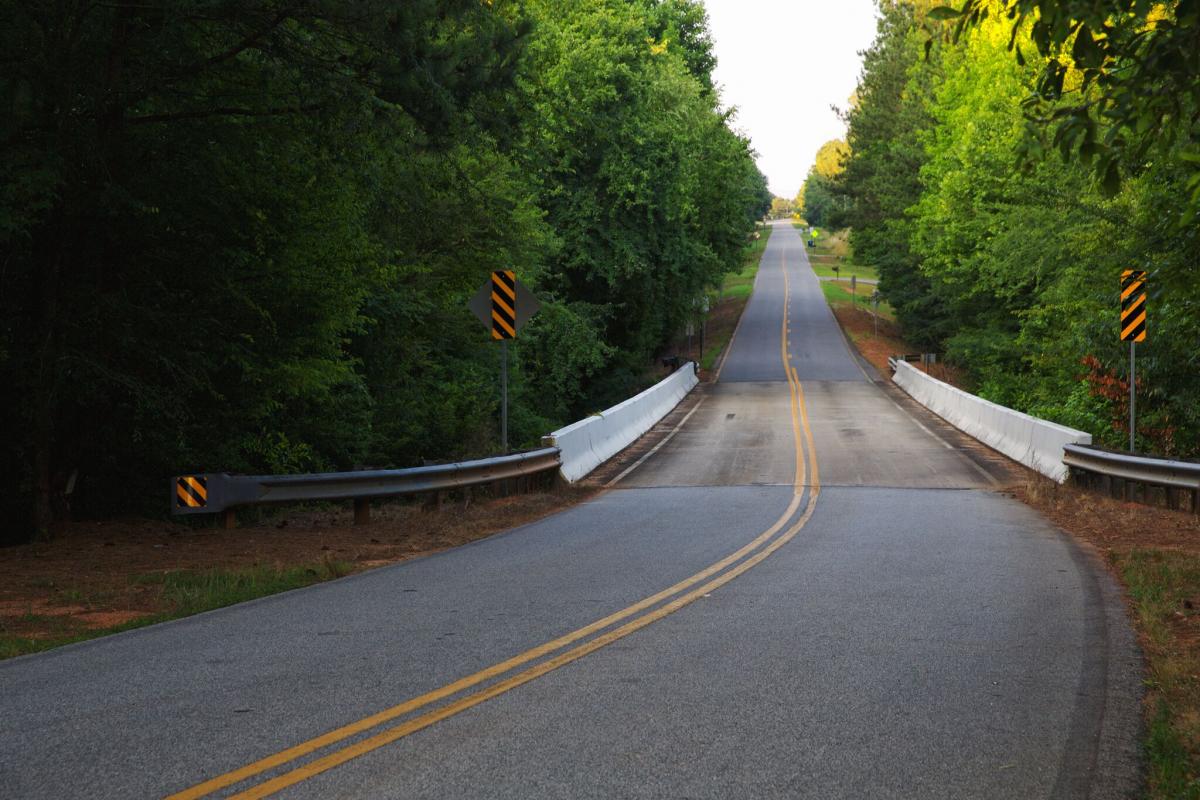
Site of the lynchings of George and Mae Murray Dorsey, Roger and Dorothy Malcom (July 25, 1946), Monroe, Georgia. (Photo by Lance Warren.)
We stood at the scene of an open investigation. Unusual among Southern lynchings, the 1946 killings in Monroe, Georgia, of two African-American couples — George and Mae Murray Dorsey and Roger and Dorothy Malcom — are the subject of an FBI probe that remains active.
Four years ago, the case seemed to crack ajar: The nephew of an alleged perpetrator, a man nearly 90 who was 18 at the time of the killings, told the NAACP that his uncle's involvement was well-known among local white people of that generation. "I want it over with," his nephew said, "the racism." The minister Hattie Lawson, who met us there and works with a group determined to secure justice, says she is certain that some of the perpetrators survive. "If they were not still alive," she reasoned, "the case would already be solved."
George Dorsey was a veteran recently returned from deployment in World War II. All four were beaten and shot in a field adjacent to the Moore's Ford Bridge, at the border of two counties in a state that saw more lynchings between 1877 and 1950 than any other in the nation. As white supremacy thrived in Georgia, Hattie told us, events on the ground in Monroe made clear that the killings were anything but random.
One day after an altercation between Roger Malcom and a white farmer — a fight that landed Roger in jail — Eugene Talmadge came to town. The populist had served two non-consecutive terms as governor, and after several years in private life he sought to lead the state again in 1946. Speaking in Monroe and elsewhere in Georgia that summer — 76 years after the passage of the 15th Amendment enshrined voting rights for all — Talmadge railed against Black suffrage. And he may have gone even farther. In an FBI report declassified in 2007, the lead investigator reported that a witness told him Talmadge offered immunity from prosecution to anyone "taking care of Negro." Whether in word or gesture, Talmadge made clear that on his watch white supremacy would reign. Hattie told us that when the Dorseys and the Malcoms were dragged down to the Moore's Ford Bridge soon after Talmadge's visit, Black residents of Monroe knew who gave — or blessed — the order.
The significance of the site remains well-known locally today, not least due to the success of Hattie and others in compelling Georgia officials to install a marker at a highly visible point along a nearby highway. Down at the river in this more hidden spot, we saw the other side of what publicizing the story means. Approaching drivers found us there with Hattie, her daughter, and our camera and audio gear. Some slowed down. Others sped up.
* * *
The Murders of Frazier and Julia Baker
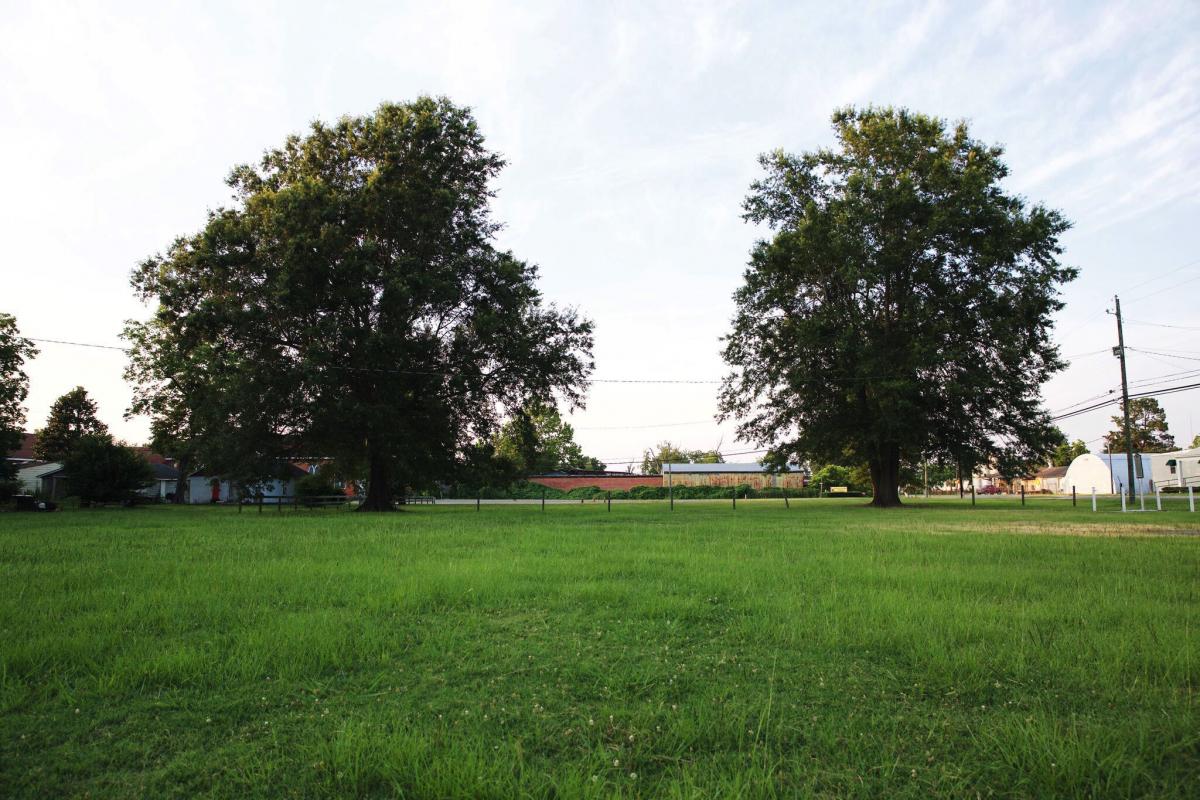
Site of the lynchings of Frazier and Julia Baker (February 22, 1898), Lake City, South Carolina. (Photo by Lance Warren.)
"Tell me something about Uncle Frazier," Fostenia Baker asked her father as they passed the abandoned land of an ancestor she never knew. "Well, honey," he answered, "it's a long, sad story."
We met Fostenia in Washington, D.C. She had moved there decades earlier, part of the Great Migration of African Americans who made wrenching decisions to leave the only homes they knew in search of opportunity — and safety — in destinations north. Fostenia's Uncle Frazier was a postmaster in Lake City, South Carolina, appointed by President William McKinley in 1897 following successful service at other post offices in the state's Pee Dee River Basin. White residents of Lake City opposed the move, and they threatened and harassed Frazier, his wife, Lavinia, and their children from the day they arrived. When Fostenia left Lake City, her move was the culmination of a family migration begun the night Frazier died.
The mob had circled the Baker home. They set it ablaze. They demanded that Frazier face them. The family clung to one another, terrorized by their neighbors. Frazier knew it was no use. "We might as well die running," he concluded, "as standing still." The postmaster emerged from the house and fell to a shotgun blast. His wife followed and felt a bullet strike her left arm, where she was holding their infant daughter, Julia. The baby was dead. The other children fled into the woods, and Lavinia followed.
When our film premiered at the Smithsonian National Museum of American History in March, Fostenia was there. The crowd applauded her. She stood — proud, but also, as a witness to terror, as a reminder of the past deeply inside our present.
* * *
"When I was growing up," the man said, "I heard there had been a lynching over by Eastern State Hospital." An attendee at one of our first screenings after the premiere, an African-American man who appeared as if he may have grandchildren, recalled stories that had shaped his sense of Williamsburg, Virginia, the colonial stage set that is also home to 21st century secrets. "I heard that, too," said a woman near the front, and another echoed her. As the evening drew to a close, the three of them talked by the door, taking first steps toward telling a different sort of Williamsburg story.
They aren't alone. But they're ahead of most. We've presented the film — "An Outrage" — to more than 4,200 people in 64 screenings reaching 27 states. Audiences have embraced the film while also sometimes worrying about what can be done to address the vast and long-hidden history it tells. We admit that it is nearly overwhelming, not only the staggering numbers of the dead, not only the sinister emptiness of the unmarked ground, but especially the contemporary patterns of destruction and ambivalence that reveal symmetries today. "How could anyone do anything that vicious?"
But we believe the truth-telling can start right there, in the thousands of towns and cities where white murderers by ones, twos, dozens, and thousands tore apart families of their African-American neighbors. The truth-telling must start there.
After joining us and 150 students for a screening at North Carolina State University last September, Blair L.M. Kelley, an historian and assistant dean, suggested that the strength we need to confront this ugly past is staring right at us: "The fact of these crimes reminds us of our own agency."
She's right. And we know that our film, like any art concerned with social justice, can do little on its own. Its power is as a hub for action, a spur to justice, an encouragement to conversations about the rumor of that lynching over by the hospital: Tell the story. Tell it again. Document it. Teach it. Make it known.
America's tradition of racial violence is not a footnote in U.S. history, but an unbroken theme — a defining characteristic of the nation's past and present. To see the history of lynching as anything less is to deny the depth and significance of injustice both then and now. And though a relative few of us may be guilty of racial violence, in a democracy — such as it is — we're all implicated.
We must do justice to this history. We owe it to those who perished, and to all those who will inherit the stories that we choose to tell — or hide.
Tags
Lance Warren
Lance Warren is a filmmaker and photographer based in Richmond, Virginia. Together with his wife, Hannah Ayers, and their production company, Field Studio, he makes media at the intersection of history and social justice.
